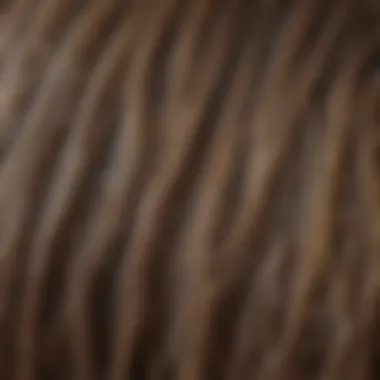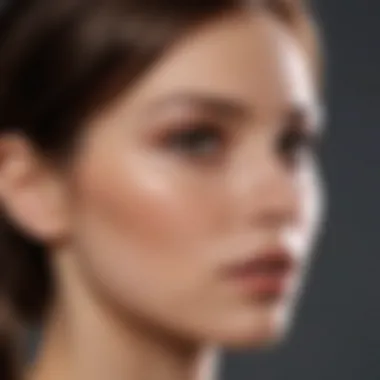Unveiling the Intricacies of Hair Thinning as You Age


Fashion Trends
Hair is a crucial aspect of our appearance that tends to undergo changes as we age. From shifts in hair texture to alterations in volume, aging impacts our hair in various ways. Understanding the science behind why hair thins with age is essential for individuals looking to maintain healthy and vibrant hair throughout the aging process. By delving into the intricacies of hair follicles and the role of hormones, we can unravel the complexities of aging hair.
Synthesizing the Information
In this comprehensive guide, we will explore the multifaceted reasons behind hair thinning with age, providing detailed insights into the factors that contribute to this phenomenon. By examining the changes that occur at a cellular level and the external influences that affect hair health, we aim to equip readers with the knowledge needed to navigate the challenges of aging hair effectively.
Introduction
In delving into the realm of aging and its effect on hair, one must grasp the significance of this topic. As we age, our bodies undergo a myriad of changes, and one noticeable aspect is the transformation our hair endures. Hair thinning is a natural process that many individuals experience. Understanding the intricacies of why and how this occurs can provide valuable insights into our overall health and well-being. This article aims to unravel the mysteries behind hair thinning with age, shedding light on the physiological and environmental factors that contribute to this phenomenon. By dissecting the science behind aging hair, we can arm ourselves with knowledge to better care for our hair as we journey through the stages of life.
Understanding Hair Structure
In this article on The Effects of Aging on Hair, delving into Understanding Hair Structure becomes imperative to grasp the complexities of how hair thins with age. By dissecting hair follicles and the hair shaft, we gain valuable insights into the intricate mechanisms that underlie the aging of hair. Understanding the different components of hair structure allows us to appreciate the holistic view of hair health and provides a foundational understanding of why hair thins as individuals grow older.
Hair Follicles
Anagen Phase
The Anagen Phase is a crucial stage in the hair growth cycle, where the hair follicle is actively producing hair. This phase's key characteristic is rapid cell division in the hair bulb, leading to visible hair growth. The Anagen Phase is significant in the context of this article as it determines the length and thickness of the hair strands. Its unique feature lies in its extended duration compared to the Catagen and Telogen phases, making it a critical contributor to overall hair density.


Catagen Phase
Contrasting with the Anagen Phase, the Catagen Phase signifies a transitional period where hair growth stops. This phase's key characteristic is the cessation of cell division in the hair follicle, leading to the detachment of the hair shaft from the blood supply. The Catagen Phase is crucial as it prepares the hair follicle for the resting phase, contributing to the overall renewal of the hair growth cycle. Its unique feature lies in its brief duration, enabling the follicle to reset for the subsequent Anagen Phase.
Telogen Phase
The Telogen Phase marks the resting period of the hair growth cycle, where the hair follicle remains dormant. This phase's key characteristic is the cessation of hair growth, with the hair shaft firmly anchored in the follicle. The Telogen Phase is vital for hair follicle regeneration and maintenance, ensuring the proper transition between hair cycles. Its unique feature lies in its role in shedding old hairs to make room for new hair growth, promoting continuous renewal and rejuvenation.
Hair Shaft
Cuticle
The Cuticle is the outermost layer of the hair shaft, serving as a protective barrier against external stressors. Its key characteristic is its overlapping structure, resembling shingles on a roof, that shields the inner layers of the hair. The Cuticle is essential for maintaining hair health by preventing moisture loss and damage from environmental factors. Its unique feature lies in its transparent nature, showcasing the underlying cortex and medulla layers while offering resilience to the hair strand.
Cortex
The Cortex forms the majority of the hair shaft, providing strength and elasticity to the hair. Its key characteristic is its fibrous structure, containing melanin pigment that determines hair color. The Cortex plays a vital role in structural support and flexibility, contributing to overall hair texture and quality. Its unique feature lies in its ability to withstand external manipulation and styling, ensuring the durability and longevity of the hair strand.
Medulla
The Medulla is the innermost layer of the hair shaft, consisting of loosely packed cells and air spaces. Its key characteristic is its variable presence in different hair types, with finer hairs often lacking a distinct Medulla. The Medulla's role in hair structure remains under research, with its significance still being elucidated. Its unique feature lies in its enigmatic nature, prompting further exploration into its functions and implications on overall hair health.


Factors Contributing to Hair Thinning
Hair thinning is a complex process influenced by various factors that play a crucial role in determining the health and density of our hair strands. In this section, we delve deep into the significance of understanding the factors contributing to hair thinning to grasp the intricacies of this natural phenomenon.
Genetics
Genetics plays a substantial role in predisposing individuals to hair thinning as they age. The hereditary aspect of hair loss can significantly impact the quality and thickness of hair strands. Variations in genes can dictate the onset and progression of hair thinning, making it essential to recognize the genetic predispositions towards this condition. Through a thorough examination of one's genetic makeup, individuals can gain insights into their susceptibility to hair thinning and take proactive measures to mitigate its effects.
Hormonal Changes
Hormonal changes have a profound impact on hair health and can lead to thinning over time. Fluctuations in hormone levels, such as androgens and estrogen, can disrupt the hair growth cycle and contribute to the gradual reduction in hair density. Understanding the hormonal influences on hair thinning is crucial in developing targeted interventions to counteract these effects and maintain healthy hair growth. By addressing hormonal imbalances through appropriate treatment strategies, individuals can potentially slow down the progression of hair thinning and preserve the vitality of their hair.
Nutritional Deficiencies
Nutrition plays a vital role in supporting overall hair health, and deficiencies in essential nutrients can exacerbate hair thinning. Inadequate intake of key vitamins, minerals, and proteins can compromise the strength and thickness of hair strands, making them more prone to breakage and thinning. Addressing nutritional deficiencies through a balanced diet and supplementation can help nourish the hair follicles from within and promote robust hair growth. By prioritizing a nutrient-rich diet, individuals can enhance the resilience of their hair and mitigate the effects of aging on hair thinning.
Stress and Environmental Factors
External stressors and environmental factors can also contribute to hair thinning by inducing damage to the hair follicles and disrupting the growth cycle. Chronic stress, exposure to pollutants, and harsh styling practices can weaken the hair strands and lead to increased shedding and thinning. Recognizing the impact of stress and environmental factors on hair health is essential in implementing protective measures and adopting healthy hair care practices. By minimizing exposure to harmful elements and managing stress effectively, individuals can safeguard their hair against the detrimental effects of aging and maintain its thickness and vitality.
Effects of Aging on Hair Growth


Hair thinning with age is a natural process that many individuals experience. Understanding the effects of aging on hair growth plays a crucial role in comprehending the changes that occur in our hair over time. As we age, various factors contribute to the thinning of hair strands, such as reduced melanin production, decreased hair density, and the thinning of hair strands. These effects can significantly impact not only our physical appearance but also our confidence and self-esteem. Hence, exploring how aging influences our hair can provide valuable insights into potential preventive measures and treatment options to maintain healthy and voluminous hair.
Reduced Melanin Production
One of the key consequences of aging on hair is the reduced production of melanin, the pigment responsible for giving hair its color. Melanin helps to protect the hair and adds richness to its hue. As we age, the melanocytes responsible for producing melanin become less efficient, leading to a gradual loss of color in our hair. This decrease in melanin production is primarily responsible for the graying of hair that many individuals experience as they grow older. Understanding this process can help individuals embrace their natural hair color changes and consider options to enhance or maintain their hair color if desired.
Decreased Hair Density
Another significant effect of aging on hair is the decrease in hair density. With age, the number of active hair follicles tends to decrease, resulting in thinner coverage of the scalp. This reduction in hair density can lead to a visible thinning of the hair, making the scalp more apparent. Factors such as genetics, hormonal changes, and nutritional deficiencies can contribute to this decrease in hair density. Individuals experiencing decreased hair density may explore various treatment options to improve hair thickness and fullness, enhancing their overall hair appearance.
Thinning of Hair Strands
As we age, the diameter of individual hair strands may also decrease, leading to overall hair thinning. Thinning hair strands can make the hair appear less voluminous and robust, affecting the overall texture and style of the hair. Factors such as hormonal imbalances, stress, and environmental influences can accelerate the thinning of hair strands. Understanding the reasons behind this phenomenon can empower individuals to make informed choices regarding their hair care routines and seek appropriate interventions to address hair thinning effectively.
Preventive Measures and Treatments
Preventive measures and treatments play a crucial role in combating the effects of aging on hair. In the quest to maintain healthy and voluminous hair, incorporating preventive strategies and treatments is paramount. By adopting a proactive approach, individuals can mitigate the impact of aging on their hair strands, promoting resilience and vitality. These measures encompass a range of practices, from lifestyle choices to targeted interventions, each offering unique benefits and considerations. Embracing preventive care not only preserves hair quality but also cultivates a proactive attitude towards aging challenges.
Healthy Lifestyle Choices
Embracing a lifestyle that prioritizes hair health is instrumental in counteracting the effects of aging. Making thoughtful choices regarding diet, exercise, and stress management can significantly impact hair density and strength. Opting for a nutrient-rich diet abundant in vitamins and minerals essential for hair growth can enhance hair resilience. Regular physical activity promotes good circulation, ensuring optimal nutrient delivery to hair follicles. Moreover, effective stress management techniques can mitigate the damaging effects of cortisol on hair health, fostering a harmonious internal environment that supports robust hair growth.
Topical Treatments and Supplements
Incorporating topical treatments and supplements into a hair care regimen can provide targeted nourishment to combat age-related hair thinning. Topical solutions enriched with potent ingredients like biotin, collagen, and antioxidants can fortify hair strands from root to tip, promoting thickness and vitality. Additionally, dietary supplements formulated to address hair health concerns can offer a convenient way to bridge nutritional gaps that may contribute to hair thinning. A holistic approach that combines topical applications with oral supplements can synergistically support hair health, addressing aging concerns comprehensively.
Professional Interventions
Seeking professional interventions from dermatologists or trichologists can offer advanced solutions for age-related hair thinning. These experts can conduct thorough assessments to pinpoint the underlying causes of hair loss and tailor treatment plans accordingly. Advanced therapies such as laser treatments, PRP (platelet-rich plasma) injections, or microneedling can stimulate hair follicles and promote regrowth. Moreover, professional guidance can provide valuable insights into personalized hair care routines and treatments, ensuring optimal outcomes for individuals grappling with aging-related hair concerns.



